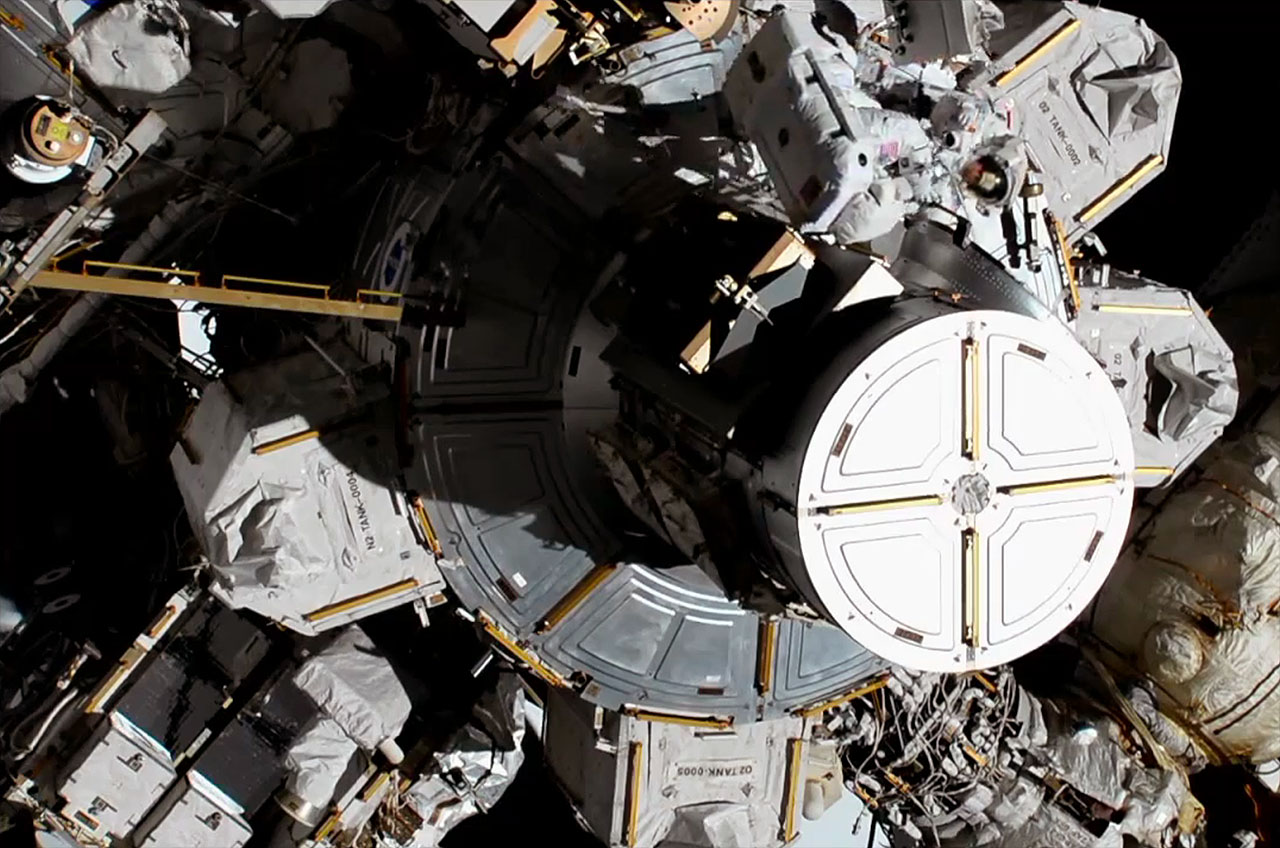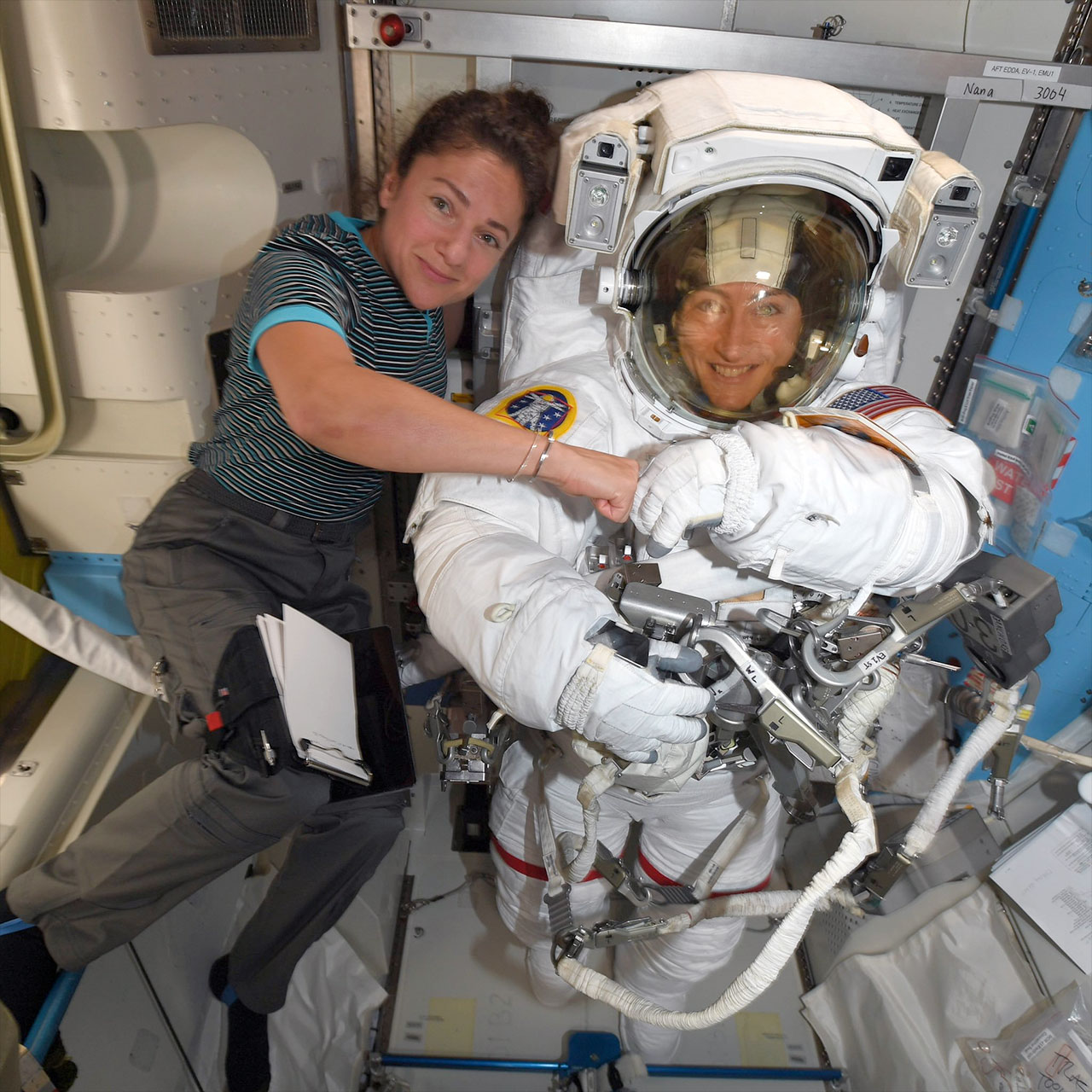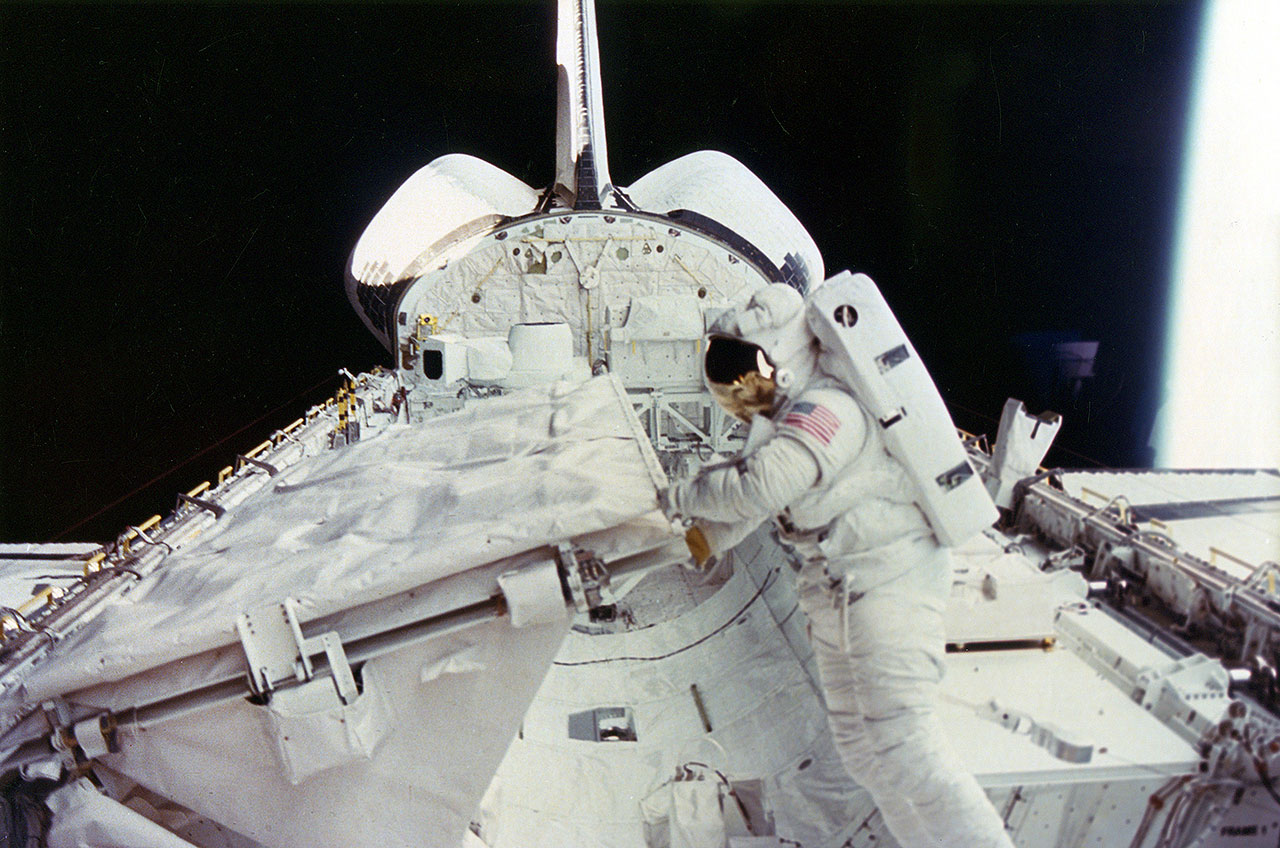First All-Female Spacewalk Has Link to First US Woman to Walk in Space
The historic action is scheduled to start at 7:50 a.m. EDT (1150 GMT).
Two NASA astronauts have made history conducting the first all-female spacewalk, and did so using a spacesuit that shares a connection to the first U.S. woman to walk in space 35 years ago this month.
Christina Koch and Jessica Meir worked outside of the International Space Station on Friday (Oct. 18) to replace a power controller that failed the week before. The malfunction interrupted a series of scheduled spacewalks to upgrade the station's exterior-mounted batteries.
Koch and Meir began their history-making spacewalk at 7:38 a.m. EDT (1138 GMT) as they switched their extravehicular mobility units (EMUs, or spacesuits) to internal power.
Watch Live: See the 1st All-Female Spacewalk by NASA Astronauts!
Related: Women in Space: A Gallery of Firsts

Meir, performing her first spacewalk, was designated EV2 and wore an all-white spacesuit.
Koch, conducting her fourth extravehicular activity (EVA), wore an EMU with red identifying stripes as lead spacewalker, or EV1.
Koch's suit was also distinguished in a more subtle way.
Get the Space.com Newsletter
Breaking space news, the latest updates on rocket launches, skywatching events and more!

According to NASA records, Koch's EMU shared a component with the same serial number as one worn by the first American woman to perform a spacewalk three and a half decades ago. The number "3008" spacesuit worn by Koch on Friday included the "1008" portable life support system (PLSS, pronounced "pliss"), the same number backpack that astronaut Kathryn Sullivan donned on Oct. 11, 1984, to become the first U.S. woman spacewalker.
NASA's EMU spacesuits were designed to be worn by many different astronauts. By switching out components, the pressure garments can be configured to fit different size crew members. The limiting piece though, is the PLSS. Only 18 of the backpacks were produced and less are in use or are still in existence today (two were lost and replaced as a result of the space shuttle Challenger tragedy in 1986 and then two more were lost with the space shuttle Columbia in 2003).
Related: The Most Memorable Spacewalks in History
The backpacks have been extensively serviced over the years and parts have been removed and replaced, but as evident by the serial number, the PLSS worn by Koch shares a legacy with the unit worn by Sullivan 35 years ago.
Sullivan, who made her spacewalk with fellow space shuttle Challenger crewmate David Leestma, was the second woman to perform an EVA. The first woman to walk in space was Svetlana Savitskaya, a cosmonaut who exited Russia's Salyut 7 space station on July 25, 1984.

Koch became the 14th woman in history to conduct a spacewalk during her first EVA in March. Meir is now the 15th to don a spacesuit and work in the vacuum in space. Koch and Meir's spacewalk was the 43rd EVA to include a woman.
The other women spacewalkers include: Kathryn Thornton, Linda Godwin, Tammy Jernigan, Susan Helms, Peggy Whitson, Heide Stefanyshyn-Piper, Sunita Williams, Nicole Stott, Tracy Caldwell Dyson, Kate Rubins and Anne McClain.
The first man to walk in space was Soviet cosmonaut Alexei Leonov on March 18. 1965. He was followed by the first American, astronaut Ed White, on June 3 of that same year. In the 54 years since, 211 more men from 11 countries have gone out on extravehicular activities.
In an interview prior to Friday's spacewalk, Koch said that gender-based records, such as the first all-female EVA, warranted attention.
"I think it's important because of the historical nature of what we're doing and in the past, women haven't always been at the table," said Koch. "It's wonderful to be contributing to the human spaceflight program at a time when all contributions are being accepted."
"What we're doing now shows all the work that went in for the decades prior, all the women that worked to get us where we are today," said Meir earlier this month. "The nice thing for us is we don't even think about it on a daily basis. It's just normal, we're just part of the team, and we're doing this work as an efficient team working together with everybody else. It's really nice to see how far that we've come."
The focus of Koch and Meir's spacewalk, the failed battery charge/discharge unit, is one of three controllers that regulates the amount of charge routed to one of the station's four power channels. It failing did not impact operations or risk the safety of the crew, but it prevented the use of a recently-installed set of new batteries.
Koch and Meir had been scheduled to perform the first all-female EVA next week, but their excursion was replanned as a result of the failed unit. Their original slated tasks have been deferred until engineers on the ground can better understand the cause of the malfunction.
- Giant Leaps: Biggest Milestones of Human Spaceflight
- The 1st All-Female Spacewalk Is Back on As NASA Gears Up for 10-EVA Marathon
- 1st All-Female Spacewalk Scrapped Over Safety Concerns, Not Sexism
Follow collectSPACE.com on Facebook and on Twitter at @collectSPACE. Copyright 2019 collectSPACE.com. All rights reserved.
Join our Space Forums to keep talking space on the latest missions, night sky and more! And if you have a news tip, correction or comment, let us know at: community@space.com.

Robert Pearlman is a space historian, journalist and the founder and editor of collectSPACE.com, a daily news publication and community devoted to space history with a particular focus on how and where space exploration intersects with pop culture. Pearlman is also a contributing writer for Space.com and co-author of "Space Stations: The Art, Science, and Reality of Working in Space” published by Smithsonian Books in 2018.In 2009, he was inducted into the U.S. Space Camp Hall of Fame in Huntsville, Alabama. In 2021, he was honored by the American Astronautical Society with the Ordway Award for Sustained Excellence in Spaceflight History. In 2023, the National Space Club Florida Committee recognized Pearlman with the Kolcum News and Communications Award for excellence in telling the space story along the Space Coast and throughout the world.











